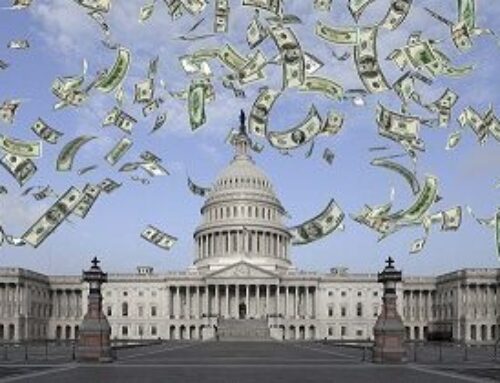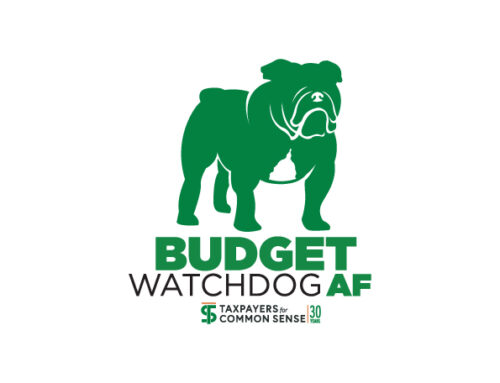In this timely episode of Budget Watchdog All Federal, host Steve Ellis and TCS Director of Research and Policy Josh Sewell dive into President Trump’s newly declared “Liberation Day” and the economic implications of his sweeping tariff plan. As the national debt exceeds $36 trillion, this episode provides essential context on how these fiscal maneuvers could further burden American taxpayers for generations to come.
Transcript
Announcer:
Welcome to Budget Watchdog All Federal, the podcast dedicated to making sense of the budget spending and tax issues facing the nation. Cut through the partisan rhetoric and talking points for the facts about what’s being talked about, bandied about and pushed to Washington, brought to you by taxpayers for common sense. And now the host of Budget Watchdog AF TCS President Steve Ellis.
Steve Ellis:
Welcome to All American Taxpayers Seeking Common Sense. You’ve made it to the right place for 30 years. TCS that’s taxpayers for common sense, has served as an independent nonpartisan budget watchdog group based in Washington DC We believe in fiscal policy for America that is based on facts. We believe in transparency and accountability because no matter where you are in the political spectrum, no one wants to see their tax dollars wasted. It’s April 1st, 2025 and no fooling around President Trump declared tomorrow is Liberation Day Liberation from what? Well, according to the president, the unfair trade practices that have been ripping off this country for decades. So how should taxpayers understand the impending tariff moves and the windfall of revenue the President is promising? And will all this provide the money needed to pay for the extension of the expiring tax cuts? Well budget watch Dog AF Faithful? The short answer to both is that taxpayers are going to be paying for the tariffs and not incentive tariff revenue should count towards offsetting deficit spending. But before I get ahead of myself here, to help us understand why budget baselines matter and that tariff is just a fancy word for tax, is TCS Director of Research and Policy Josh Sewell.
Hey Steve, glad to be here.
Well, and happy liberation, Dave Eve to you Josh.
Josh Sewell:
Thanks Steve.
Steve Ellis:
Alright, Josh, the President’s tariff plan is part of a larger strategy that involves budget reconciliation and the extension of the expiring tax cuts passed in his first term. If tariffs are taxes, does that mean taxpayers should see this as a tax hike to pay for a tax break? Tax
Josh Sewell:
Hike? Yes.
Steve Ellis:
Pay for,
Josh Sewell:
No.
Steve Ellis:
Well, thank you for your brevity. I guess I’ll turn to the Wall Street Journal editorial board to elaborate on the tax hike side. President Trump’s trade advisor, Peter Navarro said over the weekend that planned tariffs would raise 600 billion a year or about 6 trillion over 10 years, stating the message is that tariffs are tax cuts to it. The journal replied, George Orwell, call your office. In the real economic world, a tariff is a tax. If you raise $600 billion more a year in revenue for the federal government, you are taking that amount away from individuals and businesses in the private economy, by any definition, that is a tax increase. And the 600 billion figure would be one of the largest in US history. It amounts to about 2% of gross domestic product and it would take the federal tax share of GDP above 19%. The average since 1975 is about 17.3%. Democrats who love tax increases haven’t dared past such a large revenue heist. And that’s how you know it’s the Wall Street Journal editorial board. They couldn’t resist that last little jab. I like one of the comments about Liberation Day, really about liberating taxpayer cash from people’s wallets. But I digress. Josh, please elaborate on how these tariffs are a bad pay for.
Josh Sewell:
Well basically it comes down to this is all speculative revenue. Nobody knows what the tariff scheme will look like tomorrow. Nobody, not even the administration, these tariffs can and will change. That’s one thing we do know.
Steve Ellis:
It seems that President Trump changes the details by the day. Yes. On cars, no on cars, yes. On Canada and Mexico. Well actually we’ll give them a 30 day break.
Josh Sewell:
And so even when you know the details and they are consistent, you can’t actually predict consumer behavior, which is important because I can’t emphasize enough, nobody knows what the tariffs would look like and that’s not a knock on. You might like what they’re going for, you might dislike. The fact is we don’t know what the playing field will be tomorrow, let alone next year or over the next 10 years. So even more so I think it’s important to know that Trump sees tariffs as his American army knife. It’s a multi-tool to affect foreign policy, revived domestic industries and generate revenue.
Steve Ellis:
I see what you did there, Josh. Trying to avoid a tariff on Swiss army knife by making it an American army knife. Nice work. And I think to underscore what you’re talking about, I mean President Trump has called himself the tariff man. And to your point about changing environments and playing fields, I mean the whole point of the tariffs is to shift consumer and business behavior towards spending more on American made goods. If the revenue is static, they’re not working, which I would argue they don’t work anyway, especially in this blanket non-targeted approach that seems to be what’s coming down the pike tomorrow on Liberation day.
Josh Sewell:
Exactly. And it’s extremely speculative as well as very simplistic because you get to 600 billion a year by saying, Hey, we imported $3 trillion worth of imports last year. So a 20% tariff rate would be 600 billion, multiply that by 10 years, $6 trillion. It’s just simplistic and unrealistic. And that’s why lawmakers need to step back and just really use a conservative baseline.
Steve Ellis:
Wow, that’s some slide rule estimating there by advisor Navarro. So enough about tariffs for the time being here, Josh. I mean we’re a budget watchdog group and so let’s take a step back and what is a budget baseline? What does that mean?
Josh Sewell:
So in the federal government context, a baseline is the benchmark against which to frankly just evaluate the budgetary impacts of legislation. So typically budgetary impact of any proposal is measured against what’s called a current law baseline. And that reflects as it sounds, the law as it currently stands. So under that approach, extending expiring provisions would accurately reflect the cost of continuing them. Alright, that makes sense. What’s the controversy? The controversy is that there are some people in Washington right now that argue that the cost of extending expiring provisions should not be counted in a budget score as they are the policy currently in effect, this is what’s known as the current policy baseline approach and frankly it’s a budget gimmick that would allow for increases in the deficit without proper accounting. And we’re especially talking about right now about extending tax cuts that are expiring.
Steve Ellis:
Okay. Let’s dig into this a little bit more, Josh. Let’s talk a little bit more about current law versus current policy and what are some of those different effects?
Josh Sewell:
And this is both a very easy thing to conceptualize and we make it really complicated in Washington. So frankly we’ll just try to watch through this here. So current law gives you what I would call as close to a concrete base for analysis as you can get. And I say close to because you’re never going to get truly concrete. So when you look at current law, you say this policy, whatever it is, a federal program, a tax break, the current tax system, this is the law unless Congress takes action. And one thing we all know about Congress, this one and the previous one and the next one to come, Congress is great at inaction, nothing compels Congress to act. So in assuming current policy, if you did that, you are assuming that not just how this Congress will act, but the next Congress and the three or four after that. Because when scoring, it’s a 10 year baseline. So you’re assuming that you know how Congress is going to act to change the law over the next 10 years
Steve Ellis:
And especially considering Congress’s change, majorities just like happened in this Congress versus the last Congress. There’s a lot of variables there. But aren’t there some instances where current policy is assumed Josh, such as in mandatory spending?
Josh Sewell:
Absolutely. So this is where it gets a little gray now. So I can give a concrete, here we go. Example from what everybody loves the farm bill. So in the Farm Bill, which is mostly mandatory programs, farm Bill, most of those farm bill programs are authorized for only five years. Crop insurance is an exception, it’s permanently authorized. But the farm subsidy programs in title one conservation programs, some of the trade assistance, those are only put into effect for five years yet CBO, the Congressional Budget office and their baseline assumes that those programs as they’re changed in the bill last for six are also, they’re the same in year six through 10. So that whole 10 year baseline. But that assumption is actually the conservative approach and that’s because for the 50 plus years that Congress has passed a new farm bill like they are constituted now, they’ve done it every five or six years and when they don’t, they extend the previous one for one year while they’re working on the next one at the same way basically without any changes.
And so if you did current law instead of current policy with those farm bill programs, the CBO would be required to analyze the first five years under one set of assumptions and programs and then they have to come through years six to 10 and analyze it in a way, a type of policy that we haven’t even thought about for 50 years or even in some cases 70 years based on permanent law. That’s underlying some of it passed in the thirties, some of it passed in the fifties. There is nobody in the government who’s actually ever implemented this policy in our lifetimes. We don’t know how to do it. Nobody knows how to do it and nobody wants it.
Steve Ellis:
Well, my parents turned 88 this year, so most of our lifetimes fair enough. But OG AF faithful, anytime you can do a shout out to your parents, you need to do it. Okay. And I think that one of the thing that’s important here is that these rules are in effect and that does mean that lawmakers creative bunch know these rules and kind of can game the system. So certainly one of the things that we’ve talked about as an organization over the years is such things as tax extenders where these provisions are only extended for a couple of years at a time, which reduces their cost and is a way to kind of game the system. And so really in this push to do current policy, there’s some additional irony and gamesmanship going on here, right?
Josh Sewell:
Absolutely. This is a gimmick and there’s a real gimmick here in that a real expensive gimmick too. In adopting the 2017 Trump tax cuts Republicans who controlled both chambers and had the presidency deliberately used a current law of baseline. And they loved that at the time because while making most of the corporate tax cuts permanent in that legislation, changes on the individual side mostly expired most of them after eight years. So under a current law baseline, which was used again, there was no reduction in revenue in years nine and 10 because all of these tax breaks expired. And so we reverted back to the preexisting law. So it made the price tag much less than if they had actually made all of the cuts in the entire bill permanent or even if they just temporarily did it for 10 years, the entire scope of the scoring baseline. And so if you reverse course now and do what some Republicans are proposing to now use a current policy baseline to extend and perhaps expand that very same bill, the TCJA, it would mean that no Congress ever had to put their stamp of approval, which is known as a vote on cutting taxes and thus increasing deficits in years 2026 and 2027, which were years nine and 10 of the TCJA and would be years one and two of whatever tax bill gets passed. Presumably this congress,
Steve Ellis:
We’ve seen this sort of trick before certainly in the Bush administration, the tax cuts that they enacted in 2001 and 2003 both expired before the actual tenure window. And that really jammed President Obama because those were popular in large part or some of them tax cuts. So they agreed to extend and make permanent some of those provisions that maybe shave ’em down a little bit. But at least in that case they used current law in both cases. They didn’t try to use current law on the one end and current policy on the other end.
Josh Sewell:
Yeah, we’re not saying that we are for or against the entirety of the package that will come out in this specific tax bill. And the same thing in the Farm Bill or anything else where we’re having to have a discussion about costs and what baseline to use. Generally we don’t have this discussion about what baseline to use. The baseline is the baseline. And so it’s just what we need though is we need Congress to make decisions and we can’t just allow this flexibility to allow the congress or the administration to pick and choose where they’re going to enforce rules, budgetary norms and frankly basic arithmetic. And so it’s not a question about even what is the good or bad policy at this point. It’s just a question of how are you evaluating that policy against what facts and understandings. And in the end Congress, if you like tax cuts, if you like spending programs, put your stamp of approval behind it, but then you have to cover the cost because the deficit’s going to happen whether you acknowledge it or not, that money is going to be coming out of the treasury and it’s going to be piled onto the deficit and onto our national debt.
Steve Ellis:
And so budget wog faithful this decision really about whether to allow current policy, I mean it’s being pushed particularly by Senate Republicans and it’s going to be up to the Senate parliamentarian, which is a nonpartisan office to make a determination on this. And so that should happen in the next day or so. So stay tuned. And I want to underscore your point, Josh, and that is whether they use current policy or current law when they’re talking about extending the tax cut and jobs act, the TCJA you mentioned it is going to have the same effect on the deficit and debt. It may look a little cheaper if you do it through current policy, but the bottom line is when you look at the treasury, the bottom line, it’s going to be a huge expansion in the debt. And let’s make that a little more concrete. As we were saying, this is not an academic exercise. What are we talking about in deficit and debt terms, Josh, between using current policy and current law?
Josh Sewell:
So extending the tax cut and jobs act as is under current law would be about almost $5 trillion. So a little bit less, but you can round it up to $5 trillion. That’s extending as is. And so if you then wanted to add a bunch of other items that the president has proposed and he ran on such as exempting from income tax, say social security payments, taxes on tip, no taxes on tips overtime, and then some industry specific tax breaks. Once you start adding all that, the bill could be up the estimate to anywhere of between 10 and 11 trillion in foregone revenue as we call it, money that’s not going to come in. That’s how much less in tax revenue will be currently projected. So it’s an enormous cost
Steve Ellis:
And a lot of it depends on what has actually in a package I’ve seen 9 trillion, I’ve seen 10 trillion, like you said, 11 trillion. And the thing is, is that by using current policy, you then just sweep as you mentioned, that $5 trillion or nearly $5 trillion just under the rug and hide the ball from taxpayers.
Josh Sewell:
Exactly. And that’s just this one bill we’re talking about. So this could be, let’s be conservative, it’s a four to $11 trillion question on just one bill. And I can tell you right now if this goes forward, it sets precedent for picking and choosing the baseline and other things. And let’s just think it for a minute, what are other things that people would like to not have to pay for over 10 years but would love to have for one to three years and could find to pay for. But then just when year four comes, just pretend like, well, this was the policy for the last three years and not have to count for the costs. They’ve already talked about this. Some folks, the child tax credit and was actually in the TCJA, the child tax credit, the generosity was doubled from up to $1,000 per child to up to 2000 per dollars per child and the income threshold.
So instead of starting to lose your ability to take that child tax credit at $110,000 for a married couple, it’s now $400,000 for a married couple if that expansion expires this year. So it’s starting tax year 2026. So in the TCJA, they’re going to have to cover the cost of that expansion in years, what would’ve been years nine and 10, but under a current policy baseline, they won’t have to account for that cost. And then you could do what some people have proposed is let’s make it even more generous. So if you remember back during the pandemic, the trial tax credit was temporarily for one year actually made not just fully refundable and prepaid for people at the beginning of the year or I guess on a monthly basis, but also increased to $3,000 for children under the age of 17, but over the age of five and $3,600 for children under the age of six.
So 50% more expensive or generous, however you want to look at it. And then 80% more expensive for generous for a subcategory if you wanted to, you could score that under a current law baseline pay for that first year, come to year two and say, well, this was a policy and everyone loved it so much, let’s just assume since we’re going to use current policy baseline, let’s keep it for nine years. And that would’ve been a trillion dollars in cost that could have just been with the wave of a finger or a snap of a finger ignored. And so if you do it for this, and I can tell you also another thing, oh, it’s only a trillion, you guys did it with a $10 trillion price tag. This is only a trillion and it saves children. You can just see the political arguments and just pick and choose wherever else there’s a high price tag. That’s something that people really like. And this is going to become a precedent to ignore in other areas it’s fiscally irresponsible.
Steve Ellis:
Absolutely. And at this point, budget watch Faithful. Let me tell you about one of my favorite websites where I won’t say my favorite in that case, but it’s about because my favorite is of course taxpayer.net, but also in that it’s just kind of sad, is if you go to Debt to the Penny, which is the treasury’s website that tracks the national debt and you’re going to see 36 point trillion in debt. And when the tax Cut Jobs Act was passed back in 2017 when it first took effect in 2018, that debt, if you went to debt to the penny, if you went to the way back machine and looked at that date, January 1st, 2018, you would see that the debt was $20 trillion. So it’s $16 trillion more and not even a decade’s time. And now people are trying to, lawmakers are trying to talk about hide the ball and add another $5 trillion without even having to say that they’re doing it. It’s really nuts. So we started with tariffs and then we started talking about the baselines. And one of the things that we’ve talked about that also could add to debt is how the congress and the administration responds to these tariffs and what could be the impact on the debt.
Josh Sewell:
And so it comes full circle where whatever ends up happening on the tariffs is going to affect the baseline and then the debt. And so I think one things that we should anticipate here is that there are going to be bailouts. And we saw this in the last time, the Trump administration was in power and we had this increase in tariffs on significant parts of imports. Not all but significant amounts of imports. And the tariffs from foreign countries led to an anticipation of significant losses in farm country and mostly farm country, but in other areas that are considered to be very supportive of the president. It was an attempt to really leverage by foreign countries to leverage the harm on the president’s political base. And they responded, they being the administration by forking over billions in cash in order to buy the political goodwill of folks who were affected.
And so it’s been stated again, because we are not fortune tellers, we can’t predict what will happen, how consumers will behave over the next months to years. And also, again, we don’t even know what the tariffs are going to be and so we can’t anticipate foreign government actions, but we do know that something will happen where there will be some amount of response and it’s clear that the administration is willing to spend more money on a farm sector bailout, but also maybe other places because there are going to be other industries if you do put increased tariff tax, if you increase the import tax on the entirety of imports with no exceptions across the board, you’re talking currently $3 trillion worth of trade that’s going to be affected. And so that’s going to touch on every single sector. And there’s going to be a lot of folks coming to Washington asking for some assistance to weather that storm.
Steve Ellis:
Yeah, I mean it seems that we all know President Trump is the showman, and so he wants to have this big reveal tomorrow and flexibility. But the thing is, is that what we all know is that businesses and individuals want predictability. They want to know and make plans. And so certainly if a tariff regime is in effect and it stays in effect, businesses will adapt, people will adapt. But right now especially be considering he pulls things back or changes on the fly that there isn’t any of that predictability and that is starting to have a hit on the economy. Consumers are starting to hold back their spending. Businesses are either a hoarding some goods that they’re buying now because they’re worried about future tariffs, but they’re also not sure about their investment decisions. And why would you change your business approach if you think that a tariff is here for a couple months but then gone after that? And this is having a hit on the economy according to Goldman Sachs, this could lead the economy’s slow to an annual rate of just about 1% by the end of this year, Josh, they see a greater than one in three chance of recession in the next year.
Josh Sewell:
We all know how terrible I am at predicting what will happen in government shutdowns. And so I won’t get into the business of predicting a recession or not, but it’s clear that there is ambiguity, there are a lot of potential things that could happen. And the fact is that you cannot then have a very simplistic, sporadic, stationary, whatever word you want approach and say, well, we’re going to be able to raise 600 billion every single year in order to pay for these things that are going to be spent on. Because the reality is whatever happens with tariffs in the next week, over the next year over this administration, the administration like the ones before it is likely to do the spending to mitigate perceived future harms immediately. And they’re going to make those payments to farmers on losses that they anticipate once those tariffs are there.
And I can tell you just like last time, if it turns out that the tariffs do what they’re supposed to do and get better trade deals and so then they’re lifted and those harms don’t happen, Washington’s not going to ask for that money back. We didn’t last time. Farmers made out like bandits, some of them because they didn’t see losses and they got their trade assistance payment. And so they actually did much better than they had thought they would. And so you can see that same thing could happen here, but the fact is whether things are better or worse, you cannot assume we’re going to have massive amounts of revenue when we don’t know all the factors that are going to go into it. And we don’t know what’s going to happen. Especially you cannot assume that revenue to pay for things that are going to happen right now, whether it’s a tax cut or a new program or anything, we have to be more conservative and underestimate rather than overestimate.
Steve Ellis:
This all really underscores why tariff revenue has not been used and typically not allowed to be used as an offset for spending or for revenue reduction such as tax cuts. And that’s certainly something that we should not be looking at at all in the context of the baseline or in the context of the extension of the TCJA that’s being debated through reconciliation and podcast listeners. You’ve heard us talk about reconciliation before and believe me, we will be back to it again very soon. So Josh, many forecasters are talking about this. I mentioned about the slowdown in the economy and they’re looking at comprehensive tariffs that are going to further slow the economy while raising unemployment and inflation rates and budget watch Log A F faithful, you may not know this, but I’m older than Josh and I may have been a kid, but I remember the term stagflation and that’s where you have a shrinking economy and increasing prices. And that is a recipe for economic disaster. And it really took the Federal Reserve Chairman Volcker of yanking up interest rates and it’s really hard to do that. A major recession in 1981, more shocks after that to finally get the economy on track. And so it does seem to me that this is a case where potentially President Trump, Mr. Tariff man is going to kill the golden goose, which has been this long economic growth that we’ve had and strength of the economy
Josh Sewell:
And wherever you fall on, whether it’s wise to use tariffs or not, wherever you fall on support of the president’s long-term vision of the country and tariffs as a tool to get there. The fact is even this administration has acknowledged that there will be short-term pain. The question is how long is short for them? Is it a year or is it multiple years? And then the other question is how much, what’s the dollar amount behind that pain? And the reality is if there’s a recession, mild recession, dere recession, any type of recession, you’re going to see increased under current law and current policy. You’re going to see increased spending on unemployment. You’ll see increased spending on snap, the food assistance program and you’ll see trade adjustment programs. And in reality, if you really do have major changes in the imports that come into this country, building new industries or reviving industries in this country, there’s an adjustment period.
So you’re likely to see Congress passing what are known as trade or trade adjustment programs. Sometimes it’s industry specific. It helps with training and may be supposedly temporary assistance to companies as they transition into new roles. It’s going to cost money. And so even if you think you can get into a new golden age or a revived economy, a different way of making American manufacturing great again in the period between where we are now and whenever that occurs, there’s going to be significant costs. And so we need to evaluate what those decisions are, whether it’s in the tax side or the spending side against a rational, realistic, conservative math and fact-based baseline. Not what we want to have, but what we actually have now. And I think that’s really important because Congress has to, and the administration have to be held responsible for the fiscal ramifications of whatever their decisions are.
Steve Ellis:
And those ramifications can be huge. I mean, we’re looking at, like I said, a $36 trillion debt. We’re looking at interest payments that are in excess of a trillion dollars a year to service that debt. And even a short-term shock with a lot of deficit spending is going to have a huge impact on crowding out investment. The question is, is America open for business? Is it open for trade? And those are huge issues that are looming over this administration, this congress and this economy. Absolutely. Well, there you have it, podcast listeners. American taxpayers are nobody’s fool. This is the frequency. Mark it on your dial, subscribe and share and know this taxpayers for common sense has your back America. We read the bills, monitor the earmarks, and highlight those wasteful programs that poorly spend our money and shift long-term risk to taxpayers. We’ll be back with a new episode soon. I hope you’ll meet us right here to learn more.











Get Social